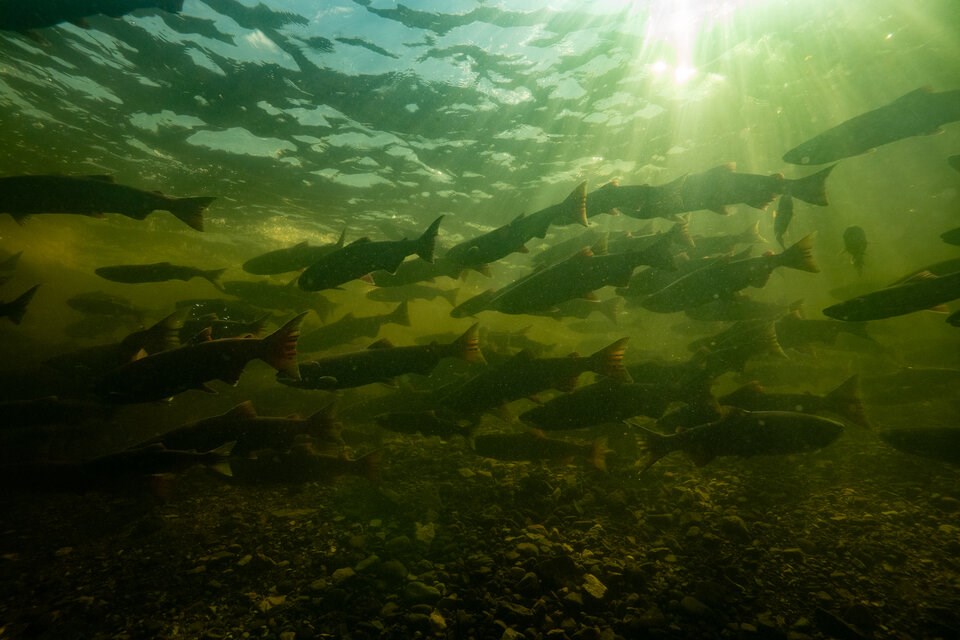A steady drop in federal monitoring has created the worst data gap for Pacific salmon stocks in 70 years — a growing blind spot at least partly linked to the priorities of commercial fisheries, a new study has found.
The research, published in the Canadian Journal of Fisheries and Aquatic Sciences, found nearly two-thirds of the salmon stocks that were historically monitored in B.C. and the Yukon have had no reported estimates between 2014 and 2023 — making it the worst decade of scientific monitoring since large-scale surveys began in the 1950s.
Fraser sockeye was found to be the only population that has seen increased monitoring over the 10-year period. Emma Atkinson, a PhD researcher at the University of Alberta who led the study, said for three of five Pacific salmon species (coho, chum, and pink salmon), changes in monitoring closely mirrored commercial value, suggesting a “strong signal” that federal monitoring is at least partly motivated by the needs of commercial fisheries.
“This data is not super glamorous,” said Atkinson. “But [it is] really a cornerstone of most of the work that’s going on with salmon.”
Atkinson said the annual salmon counts underpin scientists' ability to assess status of fish populations; how climate change, industrial activity and fishing are impacting fish; and whether recovery actions are working.
The researchers also found monitoring of the nearly 7,000 salmon populations in B.C. and Yukon has steadily declined since the 1980s — falling by half in any given year — even as an estimated 70 per cent of them sit below their long-term average abundance.
Monitoring of coho and chum salmon saw the greatest declines, while pink salmon also saw major monitoring reductions in northern and central B.C., according to the study.
In one striking example, monitoring of coho populations was found to have dropped off in the early 2000s after a fishing moratorium on the species was introduced, said Eric Hertz, an analyst at the Pacific Salmon Foundation who co-authored the study.
“A lot of the monitoring declined after that,” said Hertz. “We’re relying on fewer indicator populations to represent broader areas of the coast.”
In 2019, a lack of sufficient data to assess trends in salmon abundance led Canada’s Pacific salmon fishery to withdraw from the Marine Stewardship Council certification program rather than risk an audit with a high probability of failure.
Greg Taylor, a fisheries consultant who was not involved in the study, said a lack of monitoring and assessment makes it difficult to argue Canada is operating a sustainably managed Pacific salmon fishery.
“It’s getting more difficult to get access to international markets because people don’t want to buy non-MSC-certified salmon,” he said. “It’s an egregious failure on the part of DFO.”
Taylor said blaming the monitoring of certain salmon species on industry bias does not paint a complete picture. A focus in monitoring sockeye stocks on the Fraser River, he said, is also influenced by the fact DFO must report to the Canada-U.S. Pacific Salmon Commission and the international money that flows from it.
“There’s international eyes on doing this work now. DFO is accountable to an international body and treaty,” he said.
Whatever is driving the data gaps, Taylor said pressures from fishing and climate change could mean B.C. will lose many more salmon populations.
The result is many salmon populations important to First Nations and other food fisheries are falling by the wayside — something that Taylor expects will get worse with funding cuts.
Fisheries and Oceans Canada (DFO) is planning to cut its spending on core responsibilities and internal services by more than $1 billion next year, a 21.6 per cent drop. The cuts result from a decline in spending to fund the Canadian Coast Guard fleet, Pacific Salmon Strategy Initiative and Marine Conservation Targets, according to DFO.
On top of that, Prime Minister Mark Carney has also directed all federal departments — save the the Department of Defence, the RCMP, Canada Border Services Agency, the Supreme Court and the Parliamentary Budget Office — to cut operational spending by 7.5 per cent for the 2026-27 fiscal year, 10 per cent the following year and 15 per cent in 2028-29.
The cuts are meant to help pay for tax cuts and an increase in military spending.
“This is going to get worse,” said Taylor of the decline in salmon monitoring. “It’s really frightening to think what’s going to happen next.”
Despite the government cuts, the study’s authors note that increased monitoring could take advantage of new technologies and environmental DNA analyses to reduce costs and improve the quality of monitoring. Hertz pointed to drones and the use of artificial intelligence to help count fish.
“I think there’s some promising shifts towards First Nations monitoring. A lot of DFO monitoring is being handed over to them on the ground,” he added. “It makes a lot of sense.”




